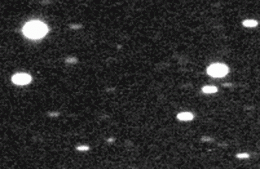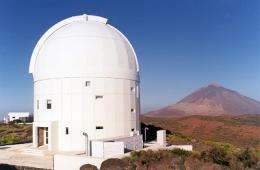Amateur skywatchers help space hazards team

For the first time, observations coordinated by ESA's space hazards team have found an asteroid that comes close enough to Earth to pose an impact threat. The space rock was found by amateur astronomers, highlighting the value of 'crowd-sourcing' to science and planetary defence.
The discovery of asteroid 2011 SF108 was made by the volunteer Teide Observatory Tenerife Asteroid Survey (TOTAS) team during an observation slot sponsored by ESA's Space Situational Awareness (SSA) programme in September.
The four-night survey used the 1m-aperture telescope at ESA's Optical Ground Station at Teide on Tenerife in the Canary Islands.
This is not the first asteroid found under SSA sponsorship, but it is the first that qualifies as a 'near Earth object' – an object that passes close enough to Earth during its orbit around the Sun that it could pose an impact threat.
Images require human evaluation
During TOTAS observations, the telescope runs automated asteroid surveys for several hours using software developed by amateur astronomer and computer scientist Matthias Busch from the Starkenburg Amateur Observatory in Heppenheim, Germany.

However, potential sightings must still be evaluated by humans.
The team comprises 20 volunteers, most of whom took part in the manual evaluation of images captured during the session on 28/29 September.
Safe distance: 30 million km
"Images are distributed to the entire team for review, and any one of them could be the discoverer of a new asteroid," says Detlef Koschny, Head of NEO activity for SSA. "This time, the luck of the draw fell to Rainer Kracht."
"As volunteer work, it is very rewarding. When you do spot something, you contribute to Europe's efforts in defending against asteroid hazards."
The orbit of asteroid 2011 SF108 brings it no closer than about 30 million km to Earth – a safe distance.
The object is the 46th asteroid discovered by Mr Kracht, a retired school teacher who lives in Elmshorn, near Hamburg, Germany. "Eight of us reviewed images on the night of the discovery, and I was lucky to be the one who found 2011 SF108 as part of this team," says Mr Kracht.
"The discovery was only possible with the excellent software developed by Matthias Busch, who also spotted this object in the images on the second night and sent the observations to the Minor Planet Center."
To date, some 8000 NEOs have been discovered worldwide but many thousands more are suspected to exist, particularly in the size of metres to hundreds of metres. It is important to find and track these to determine if any pose an impact threat to Earth.
Provided by European Space Agency



















